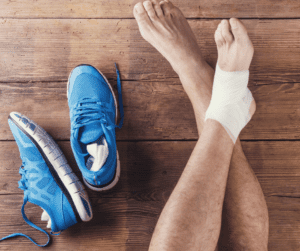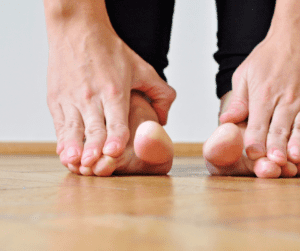The human feet are VERY complex… featuring 26 bones and an intricate network of muscles, tendons, ligaments, and fascia.
We constantly tell runners that strength and conditioning are important for your core, hips, hamstrings, and glutes… which is 100% true. But…
Most runners don’t focus on their feet, lower legs, and structures around the ankle.
We spend so much time running in training and doing the necessary strength work, we even take time out to plan our nutrition…
By strengthening your feet and the structures around the ankles, you can gain foot mobility and strength. It has been proven that strengthening your feet can be just as rewarding as strengthening any other part of your body.
Here at Coach Parry, we’re massive advocates of strength training. We’ve put together this free strength training plan for runners that you can do once a week, at home and with no expensive equipment needed. You can access it by clicking here.
Let’s have a look at exactly how strengthening your feet and ankles will contribute to stopping your feet from hurting while you run…

What Exactly Happens To Your Feet When You Run
Your intrinsic foot muscles are responsible for the stabilization of your foot.
These muscles contract eccentrically during the stance phase of running (think about when your foot arches).
Before shortening at the propulsion phase of the gait, the arch recoils with the plantar fascia. It is here where those intrinsic small muscles of the foot are vital – providing flexibility, stability, and shock absorption to the foot, whilst partially controlling pronation.
In other words, the intrinsic muscles of the foot are responsible for:
- Power absorption of the foot
- They act as protectors of the plantar fascia
- They facilitate the way your foot transfers force from the ground back into the body
There was a study done on 118 recreational runners divided into a control group (no foot core training) and an intervention group (foot core training) over a 12-month period where they were assessed every 3 months.
The group that did not receive the foot core training (control) was 2.42 times more likely to experience a running-related injury within the 12-month study period than participants in the intervention group.
This study showed that they were able to reduce the risk of injuries within 4-8 months of training the foot and surrounding structures.
I worked with an elite female South African ultra-endurance runner who went to Iten in Kenya for a 6-week training camp. She said it was an amazing experience, training in a place where running is practically a religion, where most of the best marathon runners in the world train.

She told me a story about how in one of her hour-long sports massages after a heavy week of training; the local sports massage therapist spent 20 minutes working on her feet.
It took her by surprise initially and she asked the therapist why she wasn’t spending more time on her hamstrings or glutes…The therapist replied with a somewhat obvious “because we are runners”.
When my athlete told me about this, it was like a lightbulb moment for me!
How do we, as runners, not spend more time on our feet and so the research began!
Most Common Causes Of Foot Pain/Injuries While Running
The main symptom of plantar fasciitis is pain at the bottom of your heel or sometimes at the bottom midfoot area. It usually affects just one foot, but it can affect both of your feet.
Symptoms also include pain that is worse in the morning or when you stand after sitting for a long time or a swollen heel.
- Bone Stress
Bone stress is what happens before a stress fracture. It involves pain, swelling, or aching in an isolated area.
- Stress Fracture
Stress fractures occur when there are small breaks in the bone that cause sharp pain, tenderness, and swelling.
Any bone can be susceptible to a stress fracture, but bones in the feet are the most common.
By overtraining, increasing your running load too fast, running on hard surfaces too often, or wearing the wrong running shoes you can give yourself stress fractures.
- Tendinopathy
This is a clinical syndrome that often but not always implies overuse tendon injuries characterized by a combination of pain and swelling.
Tendinopathies can occur on the lateral side of the ankle (peroneal tendinopathy) or around the heel (Achilles tendinopathy). (Note: it’s not always on the lateral side and Achilles, although these can be the most prevalent)
Now that we know why we may be experiencing pain in our feet while we run… let’s find out if we should continue running through the pain and what we can do to prevent the pain.
You may have heard us mention the term ‘foot core’ before… It’s still quite foreign to a lot of runners, so I think it’s best if we dive into it…
Everything You Need To Know About Foot-Core
To understand the foot core, I think we should explain the core of the trunk.
The “core” as we know it as runners, is all the muscles in the trunk that surround the spine, this includes muscles at the back and not just the abdominals.
The core is made up of local stabilizers (smaller muscles that stabilize the hips but do not produce a large amount of movement) and the bigger muscle groups (responsible for the main amount of movement).
Think… Smaller muscle groups – stabilizers. Larger muscle groups – movers.

When the smaller stabilizing muscles are weak or are not recruited appropriately, the larger muscle groups will take over to ensure movement occurs. This causes the foundation to be unstable and misaligned which causes abnormal movement patterns… resulting in a variety of overuse or other types of injuries.
The smaller muscle groups will continue to be weak and lazy, so we have to train them to work in the right way so that the bigger muscle groups don’t just take over.
… so the focus on training your core developed.
Your foot works in the same way – the smaller muscle groups are the stabilizers of the foot which allow for a more stable range of motion and control, and the bigger muscle groups around the lower limb control the main movement of the leg.
If we don’t work on those smaller muscles they become lazy and the bigger muscles just override them causing imbalances and injuries.
This is where FOOT CORE becomes as important as working the core of your trunk – the body works as a chain, and if there is a weak link somewhere in this chain this may present at the source or may present further or lower up the chain as a different type of injury. A
If there is weakness and lack of stability in the foot the body is going to compensate in some other way and you may find you have knee pain or hip pain (as an example) and not just a lower limb injury.
Foot core focuses on the strength and mobility of intrinsic muscles in your foot.
We spend so much time as runners on our feet… Think about it!
The intrinsic muscles in your foot are what regulate your speed and movement and allow for a bigger and more stable range of motion.
We shouldn’t just focus on strengthening the big muscle groups, we should also focus on smaller muscles that will help stop or delay our feet from fatiguing.
For people who struggle with foot injuries such as plantar fasciitis, doing foot core exercises should be a very key component of your training program as it will help prevent those injuries.
The Importance Of Strengthening Your Feet
An obvious importance of strengthening your feet as a runner is because… Well.. we run on our feet.
Secondly, every single time that you take a step, those small stabilizing muscles along with the tendons, all the different structures, and all the fascia has to work to stabilize that foot.

There are a lot of forces coming through there with every single step and that is often how injuries occur.
If we start working on the small intrinsic muscles within the feet we really can start minimizing some of those common running injuries.
The running gait requires a certain amount of movement in the toes and ankle and therefore we need to start working on some flexibility/mobility there
Part of your running is called a ‘Toe off’: The toe off starts with the push and you shouldn’t land on your toe and that happens EVERY SINGLE time your step.
Think about when you run a 5K or 10K… or even a marathon or Ultramarathon… that’s a lot of steps!
How Often You Should be Doing Foot Core Strengthening
It’s been proven that at least three sessions of foot core strengthening a week is best.
We know that just isn’t possible for the majority of us. I suggest foot core should be done daily (if you’re someone who struggles) and then every alternate day would be enough to maintain from there. (or 2-3x times per week)
In the Coach Parry programs, the foot core strengthening takes anywhere between 10 to 15 minutes so you could even do the training while sitting at your dining room table in the evenings or in front of the TV, that’s why we recommend three to four spaced out sessions per week.
How To Prevent Foot Pain While Running
We highly recommend adding some foot core work (If we haven’t made that obvious enough;)) to your training regime 2-3 times per week.
It doesn’t need to be long, 10-15 minutes per session will suffice.
If you’re already doing strength training… which we also highly recommend you do!
Do this at the end of your strength work or do these exercises before you go to bed every night.
Some younger athletes do it first thing in the morning – If you struggle with Achilles stiffness in the mornings then it’s better to do it in the evenings.
Here are some exercises we recommend you do:
- “Short-Foot” / Foot Arch
- Foot Intrinsics
- Toe Crunch
- Big toe lift with band
- Mobility
- Big Toe (neural)
- Big Toe mobility
- Ankle
- Plantar Fascia Strength / Mobility
- Lower limb stability
- Tib post
- Eccentric SL Calf Raise
We are HUGE advocates of mobility work here at Coach Parry and have created a mobility flow that you can do at home. You can access the mobility flow by clicking here.




Comments are closed.